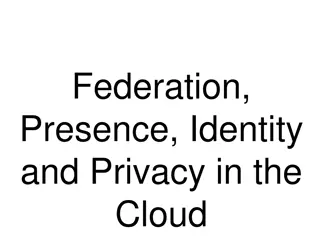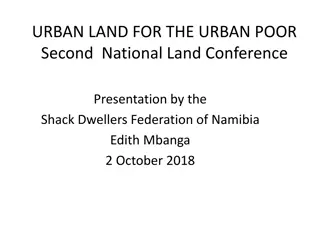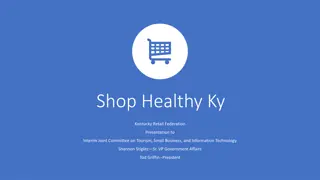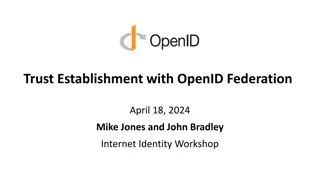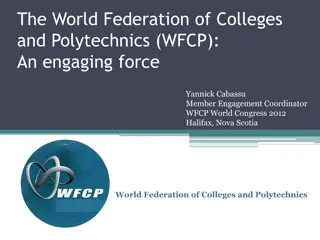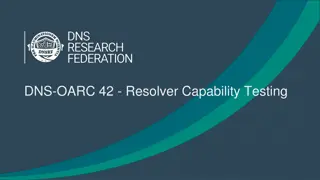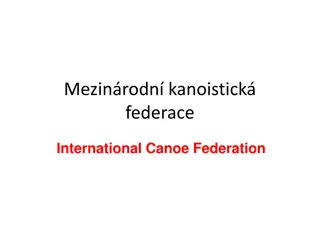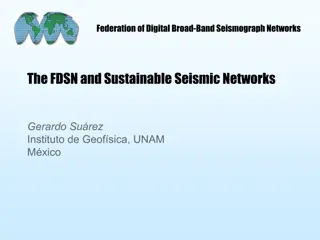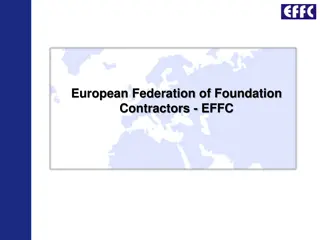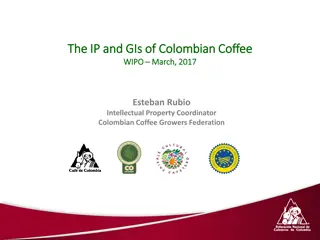
Federation
Federation in information technology enables interoperability, sharing of information, and decentralized organization. It allows for independence from global authorities, diverse solutions, and low-risk evaluation of technologies.
Download Presentation

Please find below an Image/Link to download the presentation.
The content on the website is provided AS IS for your information and personal use only. It may not be sold, licensed, or shared on other websites without obtaining consent from the author. If you encounter any issues during the download, it is possible that the publisher has removed the file from their server.
You are allowed to download the files provided on this website for personal or commercial use, subject to the condition that they are used lawfully. All files are the property of their respective owners.
The content on the website is provided AS IS for your information and personal use only. It may not be sold, licensed, or shared on other websites without obtaining consent from the author.
E N D
Presentation Transcript
Federation JENA Workshop Bologna 13th June 2023 David Britton GridPP Project Leader University of Glasgow Slide
Questions What does Federation mean? What can we Federate? Why would we Federate? How can we Federate? 2 of 11 JENA Slide David Britton, University of Glasgow
What is a Federated Architecture? Wikipedia: Federated architecture [ ] allows interoperability and information sharing between semi-autonomous de-centrally organized lines of business, information technology systems and applications. From a business perspective, data is increasingly subject to constraints on geographic location and access, so the compute is increasingly moved to the data: Federated computing . The business benefits of federation are expressed as: Being as independent as possible from a global authority such as a central computer system, central organisation, central management system , because it enables: Lifecycle independence: no complex coordination needed for product evolution. Operational independence: components can be fixed without relying on others. Platform independence: Freedom to optimise individual components. WLCG would recognise much of this. 3 of 11 JENA Slide David Britton, University of Glasgow
Federation vs Consolidation Federation: The act of uniting smaller or more localized entities to create a larger entity for mutual benefit, with an agreed mixture of common policies and local autonomy. Consolidation: The act of reducing the number of entities by dissolution of existing ones and creation of a single larger entity. Some of the steps towards Federation and Consolidation are the same (unification actions), but some of the end results are diametrically opposite. 4 of 11 JENA Slide David Britton, University of Glasgow
Why Federation and not Consolidation ? Federation allows composition of new solutions out of existing investment (but you can only rearrange the building blocks if you still have the building blocks). Federation enables decision making to be devolved down the hierarchy to where it best sits, improving choices and protecting against domination of one community or voice to the detriment of the rest. Federation can empower communities in a way that consolidation does not. All these elements become particularly important as the scale grows. Federation encourages diversity, of ideas, solutions, and people. It can protect against group think and stagnation, and can provide resilience against single points of failure both geographical and technological. Federation enables low risk evaluation and testing of future technologies, in particular where they are driven by specific well motivated communities that would otherwise be overlooked or dismissed by a large scale operation with a consolidated approach. Federation allows smaller operations to benefit from the full scale of the federation. E.g., security, identity management, accounting and allocation; but also in the building of larger communities to share ideas and solutions. Federation allows leveraging of local resources that otherwise would not be available. 5 of 11 JENA Slide David Britton, University of Glasgow
What can we Federate? Storage WLCG: federates data within a domain (experiment) to reduce number of copies (saves cost and energy). Astronomy: perhaps also across domains for multi-messenger studies. Nuclear: federated data is part of the FAIR principle. Escape data lake: Federates data (within a domain) globally. Can also share the storage hardware and service, independent of the data that it is used to store as long as the QOS is appropriate. Compute WLCG: Within and across many HEP (and some other) domain. BUT do impose common requirements (e.g 2GB/core). For large users groups, dedicated compute that is optimised for a specific set of tasks, may be better if it will be kept fully used. 6 of 11 JENA Slide David Britton, University of Glasgow
What can we Federate? Federated Software and Services Agree policies, interfaces, common tools, common services. Security; AAI; Accounting; Data management & transfer; Software distribution; etc. Networking This already is a combination of shared (eg LHCOPN) and federated infrastructure (NRENS). 7 of 11 JENA Slide David Britton, University of Glasgow
Federation Benefits (1)? Cost benefits? Ensure hardware is fully used? Not really an issue for big projects like WLCG and, eventually, SKA. Perhaps for collections of smaller projects? Reduced operational costs? Certainly from federating services and software. Reduces costs of developing and deploying new domain-specific, but similar, infrastructures where there is close alignment of requirements. Leverage! Federation enables contributions from many sources. 8 of 11 JENA Slide David Britton, University of Glasgow
Federation Benefits (2)? Quality benefits? Clearly can be benefits if federating software and services results in well- supported best-of-breed products (e.g. Security infrastructure). Access benefits? Broaden access and reduce barriers to entry with a consistent and streamlined user experience; Support structures; Ability to scale easily. Hearts and Minds! With appropriate guiding structures, an infrastructure owned by its users can be more effective and agile. Users take more ownership. It changes this isn t good enough into how can we improve this? 9 of 11 JENA Slide David Britton, University of Glasgow
UK PPAN* e-Infrastructure *PPAN = Particle Physics, Astronomy and Nuclear GridPP (UK Computing for HEP+): Federates the RAL Tier-1 and 16 Tier-2 sites as part of the Worldwide LHC Computing Grid global federated infrastructure. IRIS (UK Computing for non-HEP PPAN science): IRIS does NOT run infrastructure but provides funding for, and coordinates access (gives allocations) across, hardware infrastructures run by: GridPP (Grid computing) DiRAC (various types of HPC systems for STFC Theory communities) The STFC Scientific Computing Department (Cloud and Software services). ScotGrid NorthGrid IRIS was built on the concept of federation, where it makes sense to do so. London SouthGrid 10 of 11 JENA Slide David Britton, University of Glasgow
(A) Federation Vision Recognise that communities need gateway projects that worry about the (evolving) complexity for them. Other PPAN IRIS Share software and services where it makes sense to do so (minimises costs; maximises quality) SKA ? Theory DiRAC HEP GridPP APEL?? RUCIO/ FTS AAI? ? Network monitor? SOC ? DiRAC HPC SCD Cloud etc GridPP HTC SKA Optimise hardware for the tasks (minimises costs and energy use) Federated access and accounting Federated Data and Compute 11 of 11 JENA Slide David Britton, University of Glasgow



